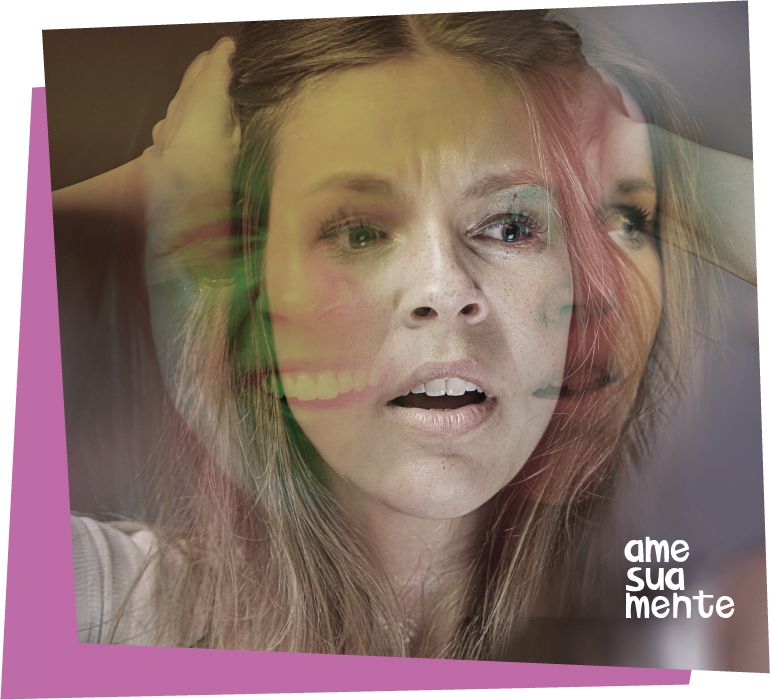
What is bipolar disorder?
“A person diagnosed with bipolar disorder alternates between states of depression with phases of normal mood and other periods of exacerbated, exalted mood,” points out Rodrigo Bressan, psychiatrist and president of the Instituto Ame Sua Mente.
Bipolar disorder is a psychiatric diagnosis that is characterized by mood changes, with phases that last an average of two to three weeks.
What is its prevalence? How does this disorder impact the population?
Bipolar affects around 140 million people worldwide. Among the diagnosed cases, approximately 80% are due to inheritance, with genetic factors as the main cause. In general, symptoms of the disorder appear before the age of 30, mainly between 15 and 25 years of age, but it can also affect older people and children. (ABRATA, Brazilian Association of Family, Friends and People with Affective Disorders –)
What are the symptoms? What are the associated signs and behaviors?
As we know, bipolar disorder’s main characteristic is intense mood swings. In the mania phase, the individual experiences intense euphoria, accelerated thinking, extreme agitation, excess energy, disinhibition (such as sexual, excessive spending or engaging in risky activities), thoughts of grandeur and a decreased need for sleep.
Hypomania is a milder manifestation of this mental state, with attenuated symptoms. People around them notice that the individual is behaving outside of their usual pattern – very talkative, aggressive or impatient – but to a degree that is easier to control, exerting less interference on the daily routine.
Another phase faced by people with bipolar disorder is depression. Characterized by periods of deep sadness, negative thoughts, apathy, lack of will and willingness to deal with everyday issues, among other symptoms.
Although difficult to distinguish, bipolar depression is different from unipolar depression. Unipolar depression usually more slowly and at long intervals. The depression that occurs in individuals with bipolar disorder appears at shorter intervals, alternating with episodes of mania and hypomania. Therefore, an accurate diagnosis made by a psychiatrist is essential, as the treatments that each condition requires are different.
What are the phases and types of bipolar disorder?
According to international diagnostic classification manuals (DSM.IV and ICD-10), bipolar disorder can be classified as follows:
Type I: the individual presents with periods of mania, which last at least seven days, accompanied by depressive symptoms, which last for two weeks or more. In both mania and depression, the symptoms are intense and cause major changes in behavior and conduct.
Type II: episodes of depression and hypomania alternate. This is the most common type.
Cyclothymic disorder: milder pattern of bipolar disorder, marked by chronic mood swings, which can occur even on the same day. The patient alternates between symptoms of hypomania and mild depression. This condition can cause doubts as to whether it is just the individual’s own temperament.
Unspecified bipolar disorder: may arise as a consequence of other illnesses or induced by substance use.
However, people with bipolar disorder may experience different symptoms during periods of depression, mania, and hypomania. See below:
Depression
- changes in appetite with weight loss or gain;
- depressed mood most days;
- fatigue or loss of energy;
- frequent discouragement and crying;
- apathy, loss of interest or pleasure;
- difficulty concentrating or making decisions due to insecurity and fear;
- recurring thoughts of death or suicide;
- agitation or slowness in speech and movements;
- insomnia or hypersomnia (increased sleep);
- feelings of guilt and worthlessness;
- discouragement and mental fatigue;
- tendency toward social isolation;
- anxiety and irritability;
- decreased libido;
- inability to feel pleasure in activities that were previously enjoyable.
Mania and hypomania
- feeling of extreme well-being;
- accelerated thinking and speech;
- agitation and hyperactivity;
- decreased need for sleep;
- increased energy;
- reduction in concentration;
- euphoria or irritability;
- disinhibition;
- impulsiveness;
- ideas of grandeur and a sense of power;
- compromised sense of danger.
What are the risks or consequences? What does bipolar disorder do to the body and mind?
Although it is a brain dysfunction, which causes memory and learning problems, bipolar disorder can sometimes damage the entire body, including inflammation within the organism. “The nervous system controls our entire endocrinological and immune system. In individuals with bipolar disorder, the brain triggers more inflammatory substances that predispose the individual to the occurrence of illnesses,” warns Bressan.
“It’s very important to note that, when we talk about inflammation, it’s not like acute inflammation. It’s something subtle, for example, a very small injury can occur over a long period of time. People with bipolar disorder are also more susceptible to obesity, myocardial infarction and changes in blood pressure,” adds the psychiatrist. Another risk arising from bipolar disorder, when left untreated, is premature aging of the immune system.
Furthermore, this is the mental disorder most associated with suicidal behavior. The estimate is that 30% to 50% of the patients, when not treated properly, attempt to commit suicide. (ABTB, Brazilian Association of Bipolar Disorder).
How to treat bipolar disorder?
The treatment of bipolar disorder endeavors to find enough stability to prevent new episodes from occurring or make them increasingly mild, with relief in times of depression and less exacerbation in times of euphoria.
It is based on medications that act directly on the brain. “In general, medications known as mood stabilizers are used. Some of them come from anticonvulsants, which treat epilepsy, including lithium. Other prescribed medications alter dopamine levels, antidepressants are only used in very special cases,” says Bressan.
Psychotherapy is also part of the treatment, since understanding one’s own behaviors, through self-knowledge, is essential so that one can identify symptoms of mania or depression crises as soon as they appear, so as to develop greater control over emotions and seek help if needed.
Bipolar disorder and stigma
Understanding bipolar disorder and many other mental disorders is very important to demystifying and reducing prejudice surrounding the topic. Stigma is one of the main obstacles that prevent people from asking for help and living a quality life.
Access hundreds of free content items on topics related to mental health, in different formats, through our menu at this link.










